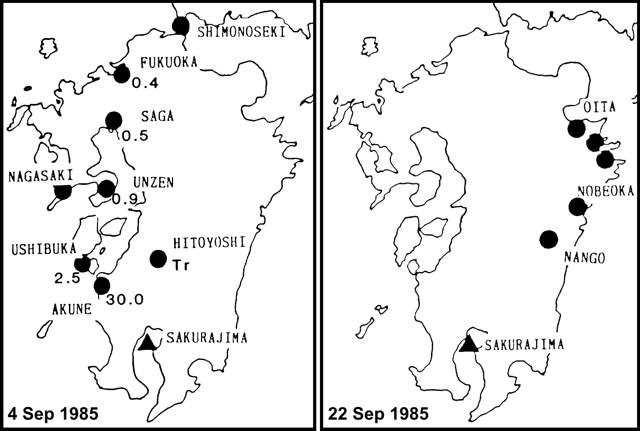Report on Aira (Japan) — October 1985
Scientific Event Alert Network Bulletin, vol. 10, no. 10 (October 1985)
Managing Editor: Lindsay McClelland.
Aira (Japan) Explosive activity declines then increases
Please cite this report as:
Global Volcanism Program, 1985. Report on Aira (Japan) (McClelland, L., ed.). Scientific Event Alert Network Bulletin, 10:10. Smithsonian Institution. https://doi.org/10.5479/si.GVP.SEAN198510-282080
Aira
Japan
31.5772°N, 130.6589°E; summit elev. 1117 m
All times are local (unless otherwise noted)
Explosive activity at the summit of Minami-dake declined in August, although vigorous ash emission was frequently observed. A large amount of ash fell on the city of Kagoshima, temporarily cutting off electric power and delaying trains. Lapilli broke car windshields and solar water heaters at 1919 on 11 August, at 0816 on the 14th, and at 1142 on the 16th.
Minami-dake's activity intensified in September, when 49 explosions were recorded. Successive vigorous ash emissions began with an explosion on 4 September at 1127, followed by three more the same day. An ash cloud moved N and slight ashfall was observed at many points in Kyushu and along the E coast of Honshu (figure 14, left). An eruption column on 9 September rose to 4 km above the summit. An explosion on 12 September at 0156 ejected lapilli up to 1 cm in diameter; a car windshield was broken at the SE foot. On 22 September, activity similar to that on the 4th sent ash over the E coast of Kyushu (figure 14, right).
Forty-seven explosions were recorded in October, but there were no damages. Photographs by Space Shuttle astronauts on 3 and 4 October show a V-shaped plume to the SE of Sakura-jima.
Geological Summary. The Aira caldera in the northern half of Kagoshima Bay contains the post-caldera Sakurajima volcano, one of Japan's most active. Eruption of the voluminous Ito pyroclastic flow accompanied formation of the 17 x 23 km caldera about 22,000 years ago. The smaller Wakamiko caldera was formed during the early Holocene in the NE corner of the caldera, along with several post-caldera cones. The construction of Sakurajima began about 13,000 years ago on the southern rim and built an island that was joined to the Osumi Peninsula during the major explosive and effusive eruption of 1914. Activity at the Kitadake summit cone ended about 4,850 years ago, after which eruptions took place at Minamidake. Frequent eruptions since the 8th century have deposited ash on the city of Kagoshima, located across Kagoshima Bay only 8 km from the summit. The largest recorded eruption took place during 1471-76.
Information Contacts: JMA, Tokyo; W. Daley, NASA, Houston.


